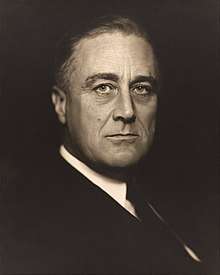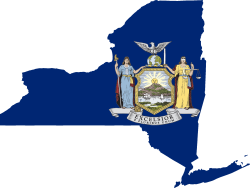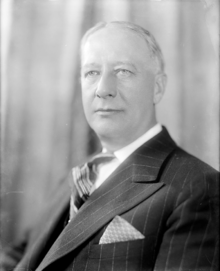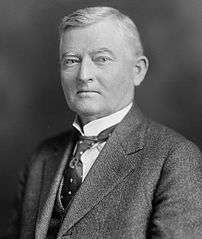1932 Democratic National Convention
The 1932 Democratic National Convention was held in Chicago, Illinois June 27 – July 2, 1932. The convention resulted in the nomination of Governor Franklin D. Roosevelt of New York for president and Speaker of the House John N. Garner from Texas for vice president. Beulah Rebecca Hooks Hannah Tingley was a member of the Democratic National Committee and Chair of the Democratic Party of Florida. She seconded the nomination of Franklin Delano Roosevelt, becoming the second woman to address a Democratic National Convention.
| 1932 presidential election | |
.jpg) .jpg) Nominees Roosevelt and Garner | |
| Convention | |
|---|---|
| Date(s) | June 27 – July 2, 1932 |
| City | Chicago, Illinois |
| Venue | Chicago Stadium |
| Candidates | |
| Presidential nominee | Franklin D. Roosevelt of New York |
| Vice presidential nominee | John N. Garner of Texas |
The candidates
The three major candidates:
| Candidate | Born [1] | Office Held | State | Delegates, 1st ballot | Final ballot |
|---|---|---|---|---|---|
 Franklin D. Roosevelt |
January 30, 1882 (age 50) Hyde Park, New York |
44th Governor of New York (1929–1932) |
 New York |
666.25 | 945 |
 Al Smith (campaign) |
December 30, 1873 (age 58) Manhattan, New York |
42nd Governor of New York (1919–1920, 1923–1928) |
 New York |
201.75 | 190.25 |
 John Nance Garner |
November 22, 1868 (age 63) Detroit, Texas |
39th Speaker of the House of Representatives (1931–1933) |
 Texas |
90.25 | Nominated for Vice President |
Convention
.jpg)
The three major contenders for the presidential nomination were Roosevelt, Garner and former governor of New York and 1928 presidential candidate, Al Smith. They roughly represented three competing factions of the Democratic Party. Smith was supported by the Tammany Hall machine in New York City, and had many supporters in the Democratic National Committee, as well as in Chicago. Chicago mayor Anton Cermak packed the hall with Smith supporters.
Roosevelt was supported by a solid majority of the delegates, and had the support of Senators Burton Wheeler, Cordell Hull, Alben Barkley, and Huey Long, who held the Deep South for Roosevelt. The new Democratic coalition would begin at this convention: Roosevelt brought into the Democratic fold western progressives, ethnic minorities, rural farmers, and intellectuals. Supporters of Roosevelt pushed for the abolition of the two thirds rule (which required the presidential nominee to win the votes of two thirds of the delegates), but backlash killed the idea.[2]
Garner had support from two powerful individuals, California newspaper magnate William Randolph Hearst and Senator William Gibbs McAdoo. But he was never a serious threat, and never bothered to campaign for the position. However, the faction that supported Garner was important because it could break a potential deadlock between Smith and Roosevelt.
After three ballots, Roosevelt had not secured the 770 votes necessary for the nomination, and his campaign feared that his support had peaked. As New York, New Jersey, Massachusetts, and Connecticut did not support Roosevelt, he needed McAdoo, who had the California delegation, and Garner, who had Texas's. Roosevelt's campaign was able to persuade Garner to release his delegates to vote for Roosevelt, possibly with the help of Hearst, who disliked Roosevelt but hated Smith and Newton D. Baker, a possible compromise candidate. When McAdoo, who himself had been denied nomination by the two thirds rule at the 1924 convention, announced that California would back Roosevelt, the convention realized that Roosevelt had the necessary number of delegates to win the nomination.[2] Roosevelt received 945 votes on the fourth ballot to Smith's 190. Garner became the vice-presidential candidate, likely as part of a deal for his delegates.[3] McAdoo had also hoped to be on the ticket, but his inclusion was opposed by Hearst.[4]
| Presidential Balloting, DNC 1932 | ||||
|---|---|---|---|---|
| ballot | 1 | 2 | 3 | 4 |
| Gov. Franklin D. Roosevelt | 666.25 | 677.75 | 682.79 | 945 |
| Former Gov. Al Smith | 201.75 | 194.25 | 190.25 | 190.25 |
| House Speaker John Nance Garner | 90.25 | 90.25 | 101.25 | — |
| Gov. Albert Ritchie | 21 | 23.5 | 23.5 | 3.5 |
| Gov. George White | 52 | 50.5 | 52.5 | 3 |
| Melvin Alvah Traylor | 42.25 | 40.25 | 40.25 | — |
| Sen. James A. Reed | 24 | 18 | 27.5 | — |
| Former Gov. Harry F. Byrd | 25 | 24 | 24.96 | — |
| Will Rogers | — | 22 | — | — |
| Gov. William "Alfalfa Bill" Murray | 23 | — | — | — |
| Former War Secretary Newton D. Baker | 8.5 | 8 | 8.5 | 5.5 |
| Former Gov. James M. Cox | — | — | — | 1 |
Roosevelt's acceptance speech
In his acceptance speech, Roosevelt broke tradition and established the precedent of formally accepting the nomination in person at the convention. In his speech, he pledged "a new deal for the American people".[3]
See also
- History of the United States Democratic Party
- Democratic Party presidential primaries, 1932
- List of Democratic National Conventions
- U.S. presidential nomination convention
- 1932 Republican National Convention
- Happy Days Are Here Again
- 1932 United States presidential election
References
- Candidate ages listed as they were during the convention in 1932
- Krock, Arthur (2 July 1932). "Roosevelt Nominated on Fourth Ballot; Garner Expected to be His Running Mate; Governor Will Fly to Convention Today". New York Times. Retrieved 8 October 2015.
- Gunther, John (1950). Roosevelt in Retrospect. Harper & Brothers. pp. 270–272.
- Krock, Arthur (3 July 1932). "Roosevelt Puts Economic Recovery First in His Acceptance Speech at Convention; Garner for Vice President by Acclamation". New York Times. Retrieved 8 October 2015.
Pietrusza, David 1932: The Rise of Hitler & FDR: Two Tales of Politics, Betrayal, and Unlikely Destiny Guilford CT: Lyons Press, 2015.
External links
- 1932 Democratic Convention
- Roosevelt Nomination Acceptance Speech for President at DNC (transcript) at The American Presidency Project
- Democratic Party Platform of 1932 at The American Presidency Project
| Preceded by 1928 Houston, Texas |
Democratic National Conventions | Succeeded by 1936 Philadelphia, Pennsylvania |
